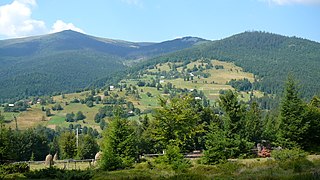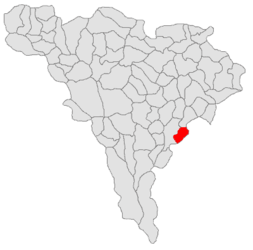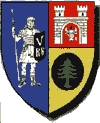
Transylvania is a historical region in central Romania. To the east and south its natural border is the Carpathian Mountains, and to the west the Apuseni Mountains. Broader definitions of Transylvania also encompass the western and north-western Romanian regions Crișana and Maramureș, and occasionally Banat.

Sibiu County is a county (județ) of Romania, in the historical region of Transylvania. Its capital city is Sibiu.

Orăștie is a city in Hunedoara County, south-western Transylvania, Romania.

The Transylvanian Saxons are a people of German ethnicity who were settled in Transylvania in waves starting from the mid-12th century until the late modern period.

Sebeș is a city in Alba County, central Romania, southern Transylvania.

The Germans of Romania represent one of the most important ethnic minorities of Romania. During the interwar period, the total number of ethnic Germans in this country amounted to as much as c. 800,000, a figure which has subsequently fallen to c. 36,000.

Biertan is a commune in Transylvania, Romania, in the north of the Sibiu County, 80 km north of Sibiu and 29 km east of Mediaș. Biertan is one of the most important Saxon villages with fortified churches in Transylvania, having been on the list of UNESCO World Heritage Sites since 1993. The Biertan fortified church was the seat of the Lutheran Evangelical Bishop in Transylvania between 1572 and 1867.

Săliște is a town in Sibiu County, in the centre of Romania, 21 km (13 mi) west of the county capital, Sibiu. Declared a town in 2003, it is the main locality in the Mărginimea Sibiului area.

Tălmaciu is a town in Sibiu County, in central Romania, 20 km (12 mi) south of the county seat, Sibiu. It lies on the eastern end of the Mărginimea Sibiului area.

Miercurea Sibiului is a town in the west of Sibiu County, in southern Transylvania, central Romania, 34 km (21 mi) to the west of the county capital, Sibiu.

Cetatea de Baltă is a commune in Alba County, Transylvania, Romania. The commune is composed of four villages: Cetatea de Baltă, Crăciunelu de Sus, Sântămărie and Tătârlaua.

Jibert is a commune in Brașov County, Transylvania, Romania. It is composed of five villages: Dacia, Grânari, Jibert, Lovnic and Văleni.

Păuca is a commune located in Sibiu County, Transylvania, Romania. It is composed of four villages: Bogatu Român, Broșteni, Păuca, and Presaca.

Șelimbăr is a commune in central Romania, in the county of Sibiu in Transylvania, to the east of the county seat Sibiu. The village of Șelimbăr has been known to exist since 1323 and is the site of the Battle of Șelimbăr.

Bazna is a commune located in Sibiu County, Transylvania, Romania. It is composed of three villages: Bazna, Boian and Velț. It lies 13 km (8.1 mi) northeast of Mediaș, within the catchment area of the Târnava Mică River.

Chirpăr is a commune located in Sibiu County, Transylvania, Romania. It is composed of four villages: Chirpăr, Săsăuș, Vărd and Veseud. Chirpăr and Veseud villages have fortified churches.

Brădeni is a commune located in Sibiu County, Transylvania, Romania. It is composed of three villages: Brădeni, Retiș and Țeline.

Laslea is a commune located in Sibiu County, Transylvania, Romania. It is composed of five villages: Florești, Laslea, Mălâncrav, Nou Săsesc and Roandola.

Adămuș is a commune in Mureș County, Transylvania, Romania. It is composed of six villages: Adămuș, Chinciuș (Kincses), Cornești (Sövényfalva), Crăiești (Magyarkirályfalva), Dâmbău and Herepea (Magyarherepe).

Alba County is a county (județ) of Romania located in the historic region of Transylvania. Its capital is Alba Iulia, a city with a population of 63,536.































